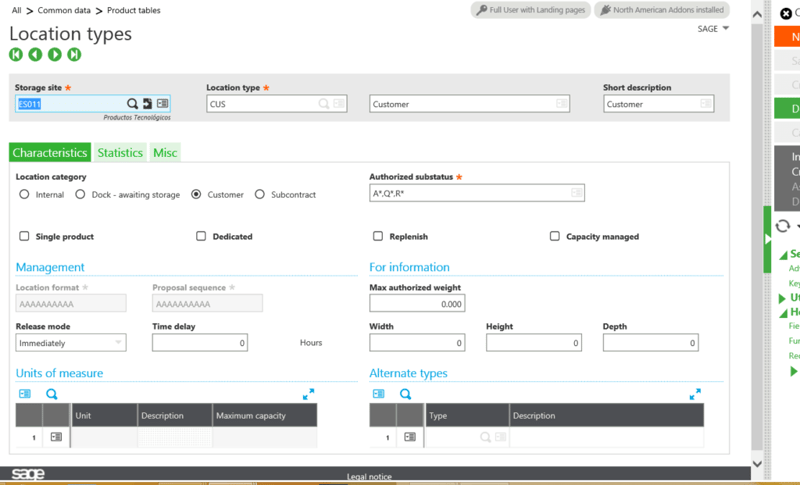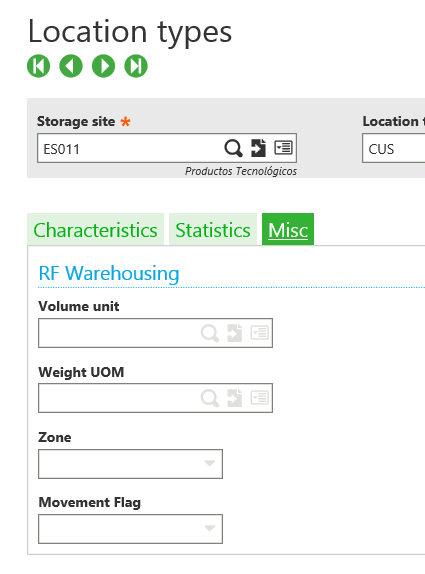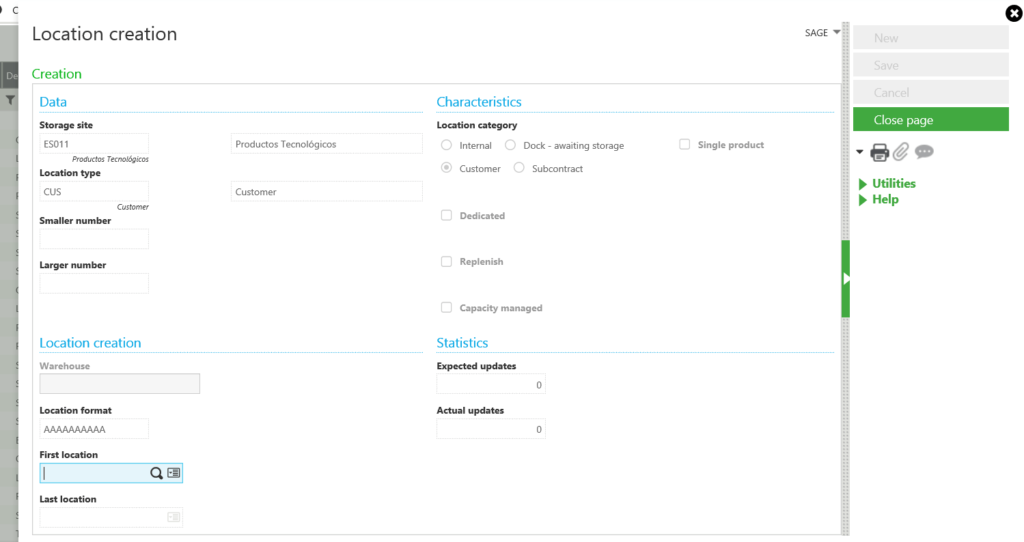Location Types on the Common Data > Product Tables menu are used to define the different location types by site. Location Types are used to group locations with similar characteristics (dimensions, storage constraints, authorized statuses, etc.) within a site/warehouse.
For example, you may have locations at the Dock, for Quality Control and stock locations.
These locations will be used when processing stock and when location management is active.
Below see where the Site is entered – a site can have an unlimited number of location types, for each location type you will need to enter a code, description and short title.
The location category determines which statuses are accepted into this location.
Internal: Used for normal locations
Dock: awaiting storage: Used to receive to a dock. It is possible to enter the location without specifying the lot, sub-lot or serial number.
Customer: Manage BP locations to manage the loan of goods to a specific BP.
Subcontract: To manage products in subcontracting locations.
Single Product: Can only accept one product at a time.
Dedicated: For fixed storage addresses. These locations are assigned to a product using the Assign locn. Button. You can attach these products to one or more storage addresses.
Replenish: This is used with the replenishment workbench and is to be refilled using the bin/location replenishment tasks. Typically used to keep picking bins full for picking outgoing shipments.
Capacity managed: Ensure that the quantity does not exceed the maximum quantity, indicated in the Units of Measurement section. Location will change to status of Occupied when there is a stock receipt above this even when it is not totally filled. Once ‘Occupied’ can no longer be used for other receipts. After all stock is issued it will have a status of ‘Free’. When the status is ‘Occupied’ you will receive a message if you try to place a product here.
Authorized Statuses: You can indicate A (accepted), Q (Quality control) or R (Rejected) here. Asterisk(*) wildcard can be used to indicate all statuses beginning with A*, Q* and/or R*. If you try to receive an item with a status not defined, a message will be displayed. You must define the format to be used for this location type:
Format of the location number:

'A' = warehouse 'B' = zone 'C' = sequence 'D' = scale 'E' = level 'F' = rack 'G' = cavity
Each letter is optional, it can be repeated but it is necessary to respect an ascending order of weights.
For instance: AAABEFF = 3 characters for the warehouse 1 character for the area 1 character for the level and 2 characters for the rack.
It is used during the location creation that can be carried out in mass between two location ranges.
The "Stock at business partner" storage mode does not follow this codification of locations. The format is forced to 10 alphabetical characters in free entry. The tabs are created one by one.
Now define a Proposal Sequence:
The proposal sequence is used to assign the free locations on stock receipt in an order other than the alphanumeric format of the location, specifically where the storage method is dynamic.
For instance: If the filling criterion gives the priority to storage in the order of the lowest level in the warehouse, the priority sequence can be AAAEBFF for a location format AAABEFF.
The locations are then proposed in the following order: 1 warehouse AAA 2 level E 3 zone B 4 rack FF
Alternate Types: Only available if Capacity managed is selected. During receipt of the stock, X3 reads the location type in the product-site record to find free locations, if none are free it searches other location types based on the entries here.
Statistics Tab: you can view the information shown below here. It is updated when running the Location Resynchronization task.
Misc tab: Only used if you have purchased RF (radio frequency) Warehousing. RF Warehousing is one of 2 options in ADC, which is bar-coding and scanning. If you have purchased RF Warehousing you would need to complete this section.
Now that your Location Type is created you will want to create Locations for this type.
You will use the Create Locn. Button on the right.
After clicking this button the screen below will appear:
Site, location type, characteristics and smallest and largest locations numbers will be displayed and cannot be changed.
At the First and Last Location, fields enter the starting and ending range for the locations that you want to automatically create.
These values must coincide with the format displayed in the Location Format field.
When you click save you will be prompted with the number of locations to be created. You can now continue and your locations will be created.
You can also delete existing locations by clicking the Delete locn. Button. You will need to enter the first and last location to delete. You cannot delete a location that contains stock. Now you know how to set up location categories in Sage X3.
Read More Sage X3 Blogs
How to Setup a Default Bank Account in Sage X3













